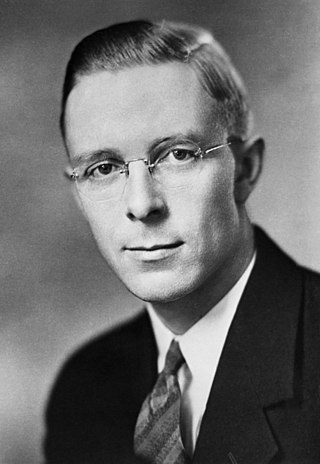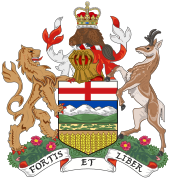
The 1935 Alberta general election was held on August 22, 1935, to elect members of the Legislative Assembly of Alberta. The newly founded Social Credit Party of Alberta won a sweeping victory, unseating the 14-year government of the United Farmers of Alberta. It was one of only five times that Alberta has changed governments.

The 1940 Alberta general election was held on March 21, 1940, to elect members of the Legislative Assembly of Alberta.

The 1967 Alberta general election was held on May 23, 1967, to elect members of the Legislative Assembly of Alberta to the 16th Alberta Legislature. The election was called after the 15th Alberta Legislature was prorogued on April 11, 1967, and dissolved on April 14, 1967.

Camrose is a provincial electoral district in Alberta, Canada. The district is one of 87 districts mandated to return a single member (MLA) to the Legislative Assembly of Alberta using the first past the post method of voting. The district was originally created in 1909 and dissolved in 1993, and recreated for the 2019 Alberta general election.
Vegreville was a provincial electoral district in Alberta, Canada, mandated to return a single member to the Legislative Assembly of Alberta from 1909 to 1963 and again from 1971 to 1993.
Red Deer was a provincial electoral district in Alberta, Canada, mandated to return a single member to the Legislative Assembly of Alberta from 1905 to 1986.
Bonnyville was a provincial electoral district in Alberta, Canada, mandated to return a single member to the Legislative Assembly of Alberta from 1952 to 1997. The Bonnyville electoral district was created in 1952 from the northern part of the St. Paul electoral district. In 1997 the riding was renamed Bonnyville-Cold Lake, to more accurately reflect the two largest population centres in the constituency.
Redwater was a provincial electoral district in Alberta mandated to return a single member to the Legislative Assembly of Alberta from 1940 to 1971 and again from 1993 to 2004.

The 15th Alberta Legislative Assembly was in session from February 13, 1964, to April 14, 1967, with the membership of the assembly determined by the results of the 1963 Alberta general election held on June 17, 1963. The Legislature officially resumed on February 13, 1964, and continued until the fifth session was prorogued on April 11, 1967, and dissolved on April 14, 1967, prior to the 1967 Alberta general election.

The 14th Alberta Legislature was in session from February 11, 1960, to May 9, 1963, with the membership of the Legislative Assembly determined by the results of the 1959 Alberta general election held on June 18, 1959. The Legislature officially resumed on February 11, 1960, and continued until the fifth session was prorogued on March 29, 1963, and dissolved on May 9, prior to the 1963 Alberta general election.

The 7th Alberta Legislative Assembly was in session from January 29, 1931, to July 22, 1935, with the membership of the assembly determined by the results of the 1930 Alberta general election held on June 19, 1930. The Legislature officially resumed on January 29, 1931, and continued until the fifth session was prorogued on April 23, 1935 and dissolved on July 22, 1935, prior to the 1935 Alberta general election.

The 9th Alberta Legislature was in session from February 20, 1941, to July 7, 1944, with the membership of the Legislative Assembly determined by the results of the 1940 Alberta general election held on March 21, 1940. The Legislature officially resumed on February 20, 1941, and continued until the fourth session was prorogued on March 24, 1944, and dissolved on July 7, prior to the 1944 Alberta general election.

The 13th Alberta Legislative Assembly was in session from August 17, 1955, to May 9, 1959, with the membership of the assembly determined by the results of the 1955 Alberta general election held on June 29, 1955. The Legislature officially resumed on August 17, 1955, and continued until the fifth session was prorogued on April 7, 1959, and dissolved on May 9, 1959, prior to the 1959 Alberta general election.

The 1937 Social Credit backbenchers' revolt took place from March to June 1937 in the Canadian province of Alberta. It was a rebellion against Premier William Aberhart by a group of backbench members of the Legislative Assembly (MLAs) from his Social Credit League. The dissidents were unhappy with Aberhart's failure to provide Albertans with CA$25 monthly dividends through social credit as he had promised before his 1935 election. When the government's 1937 budget made no move to implement the dividends, many MLAs revolted openly and threatened to defeat the government in a confidence vote.
The Accurate News and Information Act was a statute passed by the Legislative Assembly of Alberta, Canada, in 1937, at the instigation of William Aberhart's Social Credit government. It would have required newspapers to print "clarifications" of stories that a committee of Social Credit legislators deemed inaccurate, and to reveal their sources on demand.
Okotoks-High River was a provincial electoral district in Alberta, Canada, mandated to return a single member to the Legislative Assembly of Alberta from 1930 to 1971.
Spirit River was a provincial electoral district in Alberta, Canada mandated to return a single member to the Legislative Assembly of Alberta from 1940 to 1971.
Grouard was a provincial electoral district in Alberta mandated to return a single member to the Legislative Assembly of Alberta from 1913 to 1971.
Lac La Biche was a provincial electoral district in Alberta mandated to return a single member to the Legislative Assembly of Alberta from 1952 to 1971.
Lac Ste. Anne was a provincial electoral district in Alberta, Canada, mandated to return a single member to the Legislative Assembly of Alberta from 1909 to 1971.





